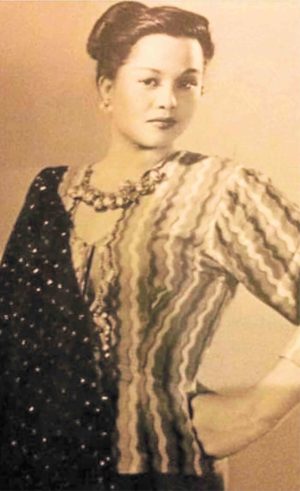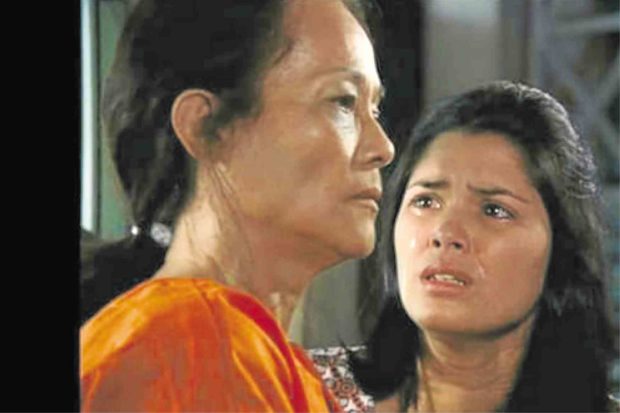Mona Lisa, a tribute
(First of a series)
Last Aug. 25, on a Sunday morning, I was in Davao City celebrating the Kadayawan Festival with kilos of mangosteen and manic soldiering ants defending their forts on my bed for breakfast. The morning easily escalated into the afternoon with delicious marang and durian sampling at the fruit stalls by the park for a makeshift lunch.
Kadayawan is a celebration of life, of the harvest of the good and the beautiful that life has to offer, of richness and of sweetness, of everlasting resource and cycles of sustenance. A festival that displays with certainty, and in plenty, what life has to give.
Later in the afternoon, a variety of fresh seafood had been laid down in a spread in front of me when I received the news from my mother that Mona Lisa—or my Lola Gloria (real name: Gloria Consorcia Yatco Guinto)—passed away at 1:14 p.m., peacefully, in her sleep.
This was not the most sudden turn of events. I have already had time to prepare myself for this day. My lola had been bedridden and battling Alzheimer’s disease for three years. Still, the contrast of life and loss, of abundance and end, will no doubt turn one’s joy into sadness.
A celebration of life, it surely was, that Sunday.
Mona Lisa’s was a long and mighty one, and it had come to a close.
Her festival had ended.
Mona Lisa, a portrait
When so much of “Lola n’ya si Mona Lisa” has been thrown about throughout my three decades of existence, the big headliner “Legendary actress Mona Lisa dies at 97” takes a while to process.
How do I say goodbye to an icon to the public, who was also the woman who raised me and my mother and was instrumental to both careers I have chosen to pursue in life? How do I watch the passing on of a legend when our last years with her had been stripped down to the most domestic of daily routines with diapers, force-feeding and restless afternoons and evenings of trying to calm her imaginary fears?
It is easy to romanticize something—or someone—that has become a part of the past. I should know because I have won awards for doing just that. Her biography, “Mona Lisa: A Portrait (From the Memoirs of a Grandmother),” which I wrote in 2013 and won a National Book Award in 2014 and the Madrigal Gonzalez First Book Award in 2015, was recognized mostly for being both beautiful and tragic, and “mean and kind.”
It is often commented that my grandmother had such “a colorful life.” Like any actress, she had a life that was highlighted with men, parties, costumes, lights, drama and studio gossip.
But beyond what is often striking to us as onlookers, she lived just as any, with mostly moments of solitude, darkness, boredom, desire and days constantly shifting between her successes and self-doubt.
Born into poverty in Tondo on June 22, 1922, only a few years before her family boarded a ship to migrate to America, she had lived as a child-laboring fruit picker in California during the Great Depression.
Back in Manila, she survived malnutrition throughout World War II as a struggling single mother—surviving with no less than having to give birth to her second child at its tail end, after running through the streets of the city cut off from electricity as she went into labor right in the middle of the American invasion.
She had worked through both the vaudeville era and the martial law years, through her teenage years and the granny babysitting-me-days, never having become fully provided for, whether in terms of opportunities or comfort by her chosen craft.
People who wish to see it in color will always be able to add color. But it seems more fitting to say that Mona Lisa’s life had been an epic film in black and white.
It took me years to finish writing her story and getting it right from my limited point of view in my present moment. I had her around my entire life, but the life I knew was different from what she had lived through. It was a challenge to find the reality in her chaos, the lessons in her mistakes, the meaning in her motivations, the humanity in the glaring spotlight in which she lived.
And in the middle of the fanfare of her passing, I had found myself again in this recurring contrast of realities, caught between the tragedy and beauty that was her life and the meanness and kindness of her fate.
No matter how I tried, I couldn’t seem to see her death despite being face-to-face with it.
All I can see now is her life.
Fleur de Lis to Mona Lisa
As a 15-year-old with a feisty personality and an American accent, my grandmother came home to the Philippines in 1937 with her mother and six siblings, after her mother had left her father for another man, and signed with Parlatone Hispano-Filipino to become an actress under the screen name Fleur de Lis.
Her first film was “Ang Pagbabalik” in 1938 with Angel Esmeralda, Mary Walter and Gerardo de Leon, who eventually became National Artist for Film.
Fleur de Lis appeared in over 10 films throughout her first year in the industry before starring with Mila del Sol, Ely Ramos and Fernando Poe Sr. in LVN Pictures’ now-restored movie musical, “Giliw Ko”—which is one of the only five remaining prewar films in existence in Philippine Cinema today.
It was in the making of the said film that my grandmother first met Poe Sr., who was to father her second son, Allan Poe.
Her first son Edward Gardner was fathered by then director Marvin Gardner (known as Eduardo de Castro), who was the one who eventually changed her screen name to Mona Lisa (“because of her sad eyes”) when she changed studios and signed on with X-Otic Films at the onset of the 1940s. Back in the day, actors would work under one “mother studio” that provided them movies to film throughout the year.
Mona Lisa was considered bold during her time. She was identified as the first actress to ever wear a bathing suit for the silver screen and agree to a real kissing scene. She also went nude before jumping into a waterfall pool for a swimming shot for the 1948 war movie, “Sunset Over Corregidor.”
The movie was filmed in two versions—one in full English dialogue and the other entirely in Tagalog and released under the title “Krus ng Digma” a month later. This was done during the postwar years.
After a short-lived love affair with an American soldier, my grandmother eventually met my grandfather Abelardo Guinto when he was cast as an extra in her film “Ulila ng Bataan” in 1952. She was no longer signed with a studio then, and the film starring Tessie Agana, Sylvia La Torre and Ramon Revilla was under Sampaguita Pictures.
Battling epileptic attacks caused by a postoperation mishap on her thyroid, my grandmother decided to retire at 30 after marrying my grandfather to focus on being a fulltime wife and mother.
She had four more children, Abelard and Marlon, my mother Evangeline and her last child Kathleen, all born in Cavite City, where my Lolo Bert was from and where they resided during most of their marriage.
Comebacks and no more crying
Mona Lisa made a comeback in the 1972 movie, “La Paloma.” Two years later, she gave her most recognized portrayal as Tonya in Lino Brocka’s “Insiang.” Her performance won her numerous nods and awards for both best supporting actress and best actress and is, until now, considered to be her finest work.
After the success of “Insiang,” however, she was quickly faced by the reality that there was still a great lack of opportunities to play good and challenging roles. Indie films weren’t much of a thing then.
After all the applause and recognition, Mona Lisa was soon only getting what she called the “flower vase” roles, and I remember her doing interviews in which she would be vocal in asking the industry for better-quality roles.
She became typecast as a villain and I spent a chunk of my childhood watching her every day in “Annaluna,” a long-running soap opera in the ‘90s wherein she played the evil grandmother, Doña Martina, to the young heroine.
I would often be asked as a child what she was like in person. It amused me how she was nothing like how I saw her every day on television after school. After all, she took care of me most days. She cooked, cleaned, told me bedtime stories that didn’t star her as the villain.
At home, she was still assigned to a “flower vase” sort of role, I guess, keeping things together, supporting everyone. But in theater, we say that there are no small parts, only small actors. And in my eyes, my Lola Gloria certainly was no small actor. She has always been my star storyteller.
It took a few more decades before Mona Lisa went on to her second retirement and, this time, it was for good.
Her last film was Nick Joaquin’s “Mother Ignacia” in 1999. Fourteen years later, she made her comeback and final public appearance, only for her biography’s launching on her 91st birthday at the Cultural Center of the Philippines.
In this last week of August, news articles and followers of Philippine Cinema mourned the sudden loss of “a legend.” And yet, Mona Lisa had already been lost to the industry years ago, ever since she refused to appear in anything and had, for years, declined a number of offers including playing opposite Anita Linda in Brillante Ma Mendoza’s award-winning “Lola” and other independent film projects.
In those first years of Mona Lisa saying “no” in response to phone inquiries for another comeback, she would explain, “I no longer want to cry in front of the camera at 1 a.m.” I only understood the weight of that consistent statement of hers when I joined the industry myself.
In later years, Lola would confide in us, perplexed, “There is a problem with my tear glands. I cannot cry anymore.” We made fun of her statement because she was obviously so tough that she had actually lost the physiological ability to produce tears.
She never cried at all with us. Her best-known work for crying was in the final scene of “Insiang,” where Brocka had asked for a tear to fall from her left eye on cue when Hilda Koronel stands up and leaves her. She accomplished it after a number of frustrated tries; but with us, at home with her family, there were never such requirements or feats.
I would guess that her disinterest to return to the silver screen had nothing to do with the function of tear glands. There were reasons much deeper. She had always been an actress for practical reasons, not for neither the glamour nor the art of it. She needed it for her survival—until she didn’t anymore.
But when she passed, according to my aunt who was at her bedside, a single glimmering tear fell from her eye, as if following a cue, as if leaving with one final comeback of a performance.
(To be continued)

